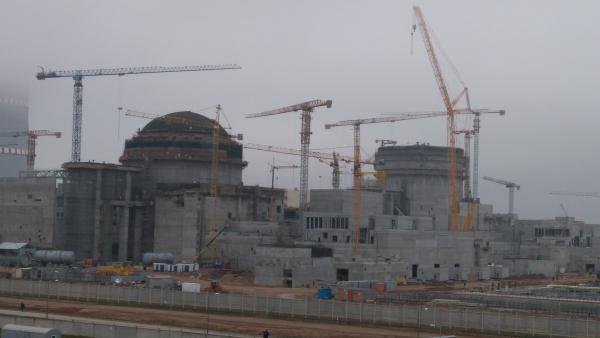The idea to build a Belarusian nuclear power plant was announced in 2008. This was preceded by public statements by the Presidents of the Russian Federation and Belarus about the tragedy of the collapse of the Soviet Union — writes Maxim Bielawski from Razumkov Center for BiznesAlert.com.
Twelve years have passed. In August 2020, physical start-up operations of the first power unit of the nuclear power plant in Ostrovets began. This means that commercial operations will occur in the first quarter of 2021. In fact, from that moment on, Belarus turns from an importer of electricity into an exporter. However, this is only virtual. Since there are no people willing to buy Belarusian electricity. Poland and the Baltic states have expressed their categorical position. Ukraine has enough of its generating capacities, which are fully capable of meeting the demand on the domestic and foreign markets.
The Russian Federation expected such a market reaction. In spite of everything, it continues to finance the project by 90% and gives Belarus access to up to $ 10 billion in loans.
What is Moscow’s interest? Moreover, how will Belarus pay debts?
The answer to these questions can be found in the true goals of the Russian Federation. Let us consider three options.
First hypothesis. Defense
Today, Rosatom Corporation is building nuclear power plants in Belarus, Finland, and Hungary. Also, the Russian authorities hope to build new power units in the Czech Republic. The geography of nuclear projects resembles the borders of the former eastern bloc during the Cold War. This fact suggests that the Russian Federation is using energy to increase the political dependence of the Central European countries and create a conditional defensive line.
Moscow’s strategy is likely to be as follows. A nuclear power plant is a critical infrastructure facility as well as a source of potential radioactive contamination. Therefore, it is possible to exclude the conduct of large-scale military actions by placing nuclear power units at a certain distance.
Second hypothesis. Attack
The deployment of nuclear power plants in European countries also makes it possible for the Russian Federation to predetermine a profitable fairway for a potential clash with NATO forces.
For example, the Suwalki corridor. Its width is 100 km. Napoleon Bonaparte in 1812 used this direction for his attack on Smolensk. The German commander Hindenburg in 1914 took advantage of this area to attack the Russian Empire. Fascist troops in 1939 occupied the territory through this region according to the Molotov-Ribbentrop pact.
Perhaps the Kremlin expects that the relief of this region from Poland’s side is difficult for the rapid movement of tank and mechanized troops. Using such conditions, the Russian troops hope to gain superiority. The purpose of such a military operation may be the opening of a land corridor to the Kaliningrad region, the annexation of the Baltic countries, access to mineral resources.
It is noteworthy that there are sufficient reserves of titanium and vanadium in the vicinity of the city of Suwalki. Alloys of these metals are used in nuclear power and the space industry.
After the occupation of the Ukrainian Donbas and Crimea, access to shale gas and hydrocarbon deposits in the Black and Azov Seas was lost. This was preceded by the events in 2012–2013, when the government, loyal to the Russian Federation, actively financed work on the development of gas fields and new infrastructure in Crimea. Also, the long-term occupation of the Ukrainian Donbas would have been impossible without alternative sources of gas supplies from the Russian Federation.
Therefore, the construction of a Belarusian nuclear power plant is a strategic investment of the Russian Federation. It may be necessary for a reliable power supply to Kaliningrad, Belarus, as well as the Baltic states in the reconstruction of the new format of the Soviet Union. Additional amounts of energy will also be needed to accommodate additional RF armed forces.
This hypothesis deserves a separate analytical study.
Third hypothesis. Geopolitical influence
It was Stalin who suggested using energy resources to solve geopolitical problems, leveling the needs of the state, immediately after the end of World War II.
For the first time, such a political instrument of influence, despite an acute shortage on the domestic market, was tested in 1948 due to the supply of oil and oil products to Finland and Bulgaria. Together with the supply of energy resources, Finland made concessions and pledged to refuse to join NATO and promised to be a non-aligned state.
From the first day of its foundation, the Russian Federation has been building its foreign and domestic policy based on the principle of a single descendant of the USSR.
Moscow is constantly repeating two historical narratives. The first is that the Soviet Union independently defeated the German fascist regime. Second, the USSR supported the countries of Central and Eastern Europe, in particular with the supply of energy resources.
This means that the current Kremlin administration has set a strategic course for restoring Moscow’s global influence according to Soviet plans. Therefore, the Russian Federation is actively acting on the energy front, building nuclear power plants, new pipelines, LNG infrastructure, developing the Arctic region, financing armed conflicts to eliminate competitors, and also lobbying through the corrupt elites of other countries for convenient conditions for the sale of Russian electricity, oil, and other resources.
In fact, for the Russian Federation, the struggle for the role of the USSR in history has become the main driving force behind its aggressive geopolitics and a necessary condition for its future existence. In particular, the historical significance of the Soviet Union is also required by the Kremlin to strengthen strategic cooperation with China, where the communist ideology is the foundation of all state processes.
To summarize, Moscow is considering all three scenarios: defense, attacks, and restoration of geopolitical influence.
Therefore, the countries of the European Union need to develop cooperation with NATO, to maintain unity and democratic values.
Source:






